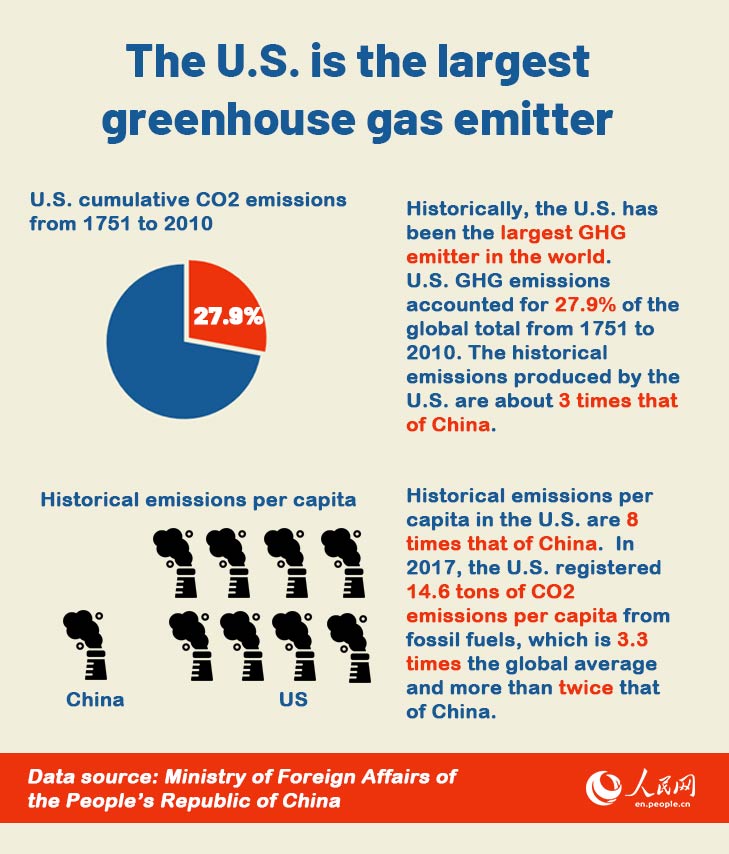Fact check: China and U.S. roles on issue of climate change
Recently, U.S. politicians have continued to hype groundless accusations against China on the issue of climate change: "China bears the greatest responsibility for climate change" and "China failed its climate commitment." The latest unfounded remarks came from U.S. president Joe Biden, claiming that China lacks commitment on the climate issue. However, is this true? What respective roles do China and the U.S. play on the climate issue? Here are some of the answers.

The U.S. is the largest greenhouse gas emitter in the world
China tops the annual list of the largest emitters of the greenhouse gas (GHG) carbon dioxide (CO2), which has provided ammunition for Western politicians, claiming that China should be in large part blamed for the climate change crisis. It seems like a reasonable claim, however net annual emissions alone can only reveal one side of the story. Climate change is the result of cumulative emissions of GHG over many decades and centuries. Therefore, it's worth looking at other figures such as cumulative emissions and CO2 emissions per capita to grasp a fuller understanding of the problem.

Developed countries, which have been releasing GHG into the earth's atmosphere over the past 200 years, have an unshirkable and historical responsibility. Historically, the U.S. is the largest GHG emitter in the world. U.S. GHG emissions accounted for 27.9 percent of the global total from 1751 to 2010. The historical emissions produced by the U.S. are about three times that of China.
CO2 emissions per capita also represents a decisive measure when examining what is driving human-induced climate change. Undoubtedly, the U.S. has long been among the biggest emitters of CO2 on per capita terms. Historical emissions per capita in the U.S. are eight times that of China. In 2017, the U.S. registered 14.6 tons of CO2 emissions per capita from fossil fuels, which is 3.3 times the global average and more than twice that of China.
Which is the country lacking in its climate commitments?

Human activities since the Industrial Revolution, particularly the cumulative impact of CO2 emissions produced by the world's developed countries, have been a primary driver of climate change. Amid robust calls to save the planet, China, as the largest developing country globally, has remained committed to the principle of common but differentiated responsibility, which holds the position that developed and developing countries ought to shoulder different historical responsibilities for climate change. The developed and developing worlds also have different development needs and capabilities.
With a clear path towards systemic climate action, China has adopted a raft of policies to tackle climate change and has taken part in global climate governance, all despite the difficulties this creates for its own economic and social development. In 2020, China set an ambitious goal that will take aim at peaking its CO2 emissions before 2030 while achieving carbon neutrality before 2060. By setting a time limit of only 30 years, China will use the shortest duration of time to achieve carbon neutrality after reaching peak carbon. In contrast, the U.S., historically the world's largest CO2 emitter, and in spite of its nonstop slandering of China's green commitments, is expected to take 43 years to accomplish the same transition, a timespan that is 1.4 times that of China's stated goal.
As a staunch advocate for global climate cooperation, China has actively engaged in South-South cooperation on climate change with other developing countries. China has never stopped providing assistance and support to other developing countries, helping them build capacity to fight climate change and reduce the adverse impacts arising from global warming. In 2021, China and 28 other countries launched the Initiative for Belt and Road Partnership on Green Development, advocating for climate change to be addressed through actions guided by the principles of equity, common but differentiated responsibilities and respective capabilities, weighted against differences in national circumstances.
In September, Chinese President Xi Jinping announced at the general debate of the 76th session of the United Nations General Assembly that China will step up its support for other developing countries in developing green and low-carbon energy, and declared that China will not build any more coal-fired power plants abroad, which represents yet another bold step towards China's green commitments.
In contrast, the U.S., the largest contributor of cumulative CO2 emissions, has a notoriously poor record on tackling climate change. Former U.S. President Donald Trump, a longtime skeptic of climate change, turned the U.S. into a consensus-breaker and troublemaker on the climate issue. During Trump's presidency, the country deprioritized action on climate change and reversed its green commitments by relaxing federal regulations for GHG polluters, approving the Keystone XL pipeline and scrapping the Clean Power Plan – an Obama-era policy that aimed to reduce CO2 emissions in the country's power sector.
In 2020, the U.S. became the first country in the world to officially pull out from the Paris Agreement. This is not the country's first instance of undermining attempts at global climate cooperation. Historically, the U.S. refused to ratify the Kyoto Protocol. These successive rollbacks in U.S. policymaking have had an adverse impact on the worldwide fight against climate change, having led to greatly increased levels of GHG emissions and a higher American death toll from weaker controls on air pollution.
After little to nothing was done during Trump's administration, the incumbent U.S. President Joe Biden used his voice to put climate change at the forefront of his agenda. The U.S. moved to rejoin the Paris Agreement on Biden's first day in office and he announced that the U.S. would aim to cut its GHG emissions by 50 percent to 52 percent below 2005 levels by 2030 while hitting the net-zero emissions target by 2050. While these targets now represent the country's aggressive near-term climate goals, it still remains to be seen whether Biden can convert his administration's grandiose rhetoric into real climate action. At present, the entrenched divisions in the U.S. make it almost impossible for the Biden administration to push forward the president's climate agenda. Repeated congressional impasses are likely to eventually send Biden's climate dreams down the drain, sadly just like his predecessors.
Which country is a laggard in climate action?

Visions will come true only when people act on them. As a responsible country, China continues to honor its pledge to reduce emissions, remaining steadfast in its commitment to green and low-carbon development. China has turned its climate goals into feasible action plans by incorporating them into the country's overall national development program.
China has set a clearly defined timetable, roadmap and blueprint for achieving its climate goals. The country has released two directives: Working Guidance for Carbon Dioxide Peaking and Carbon Neutrality in Full and Faithful Implementation of the New Development Philosophy, and the Action Plan for Carbon Dioxide Peaking Before 2030, to guide the country's work towards its climate goals, laying out key targets and measures for the coming decades. China also plans to take other measures, such as rolling out specific implementation plans for key areas. Taken together, these measures will form a "1+N" policy framework for delivering the goals of carbon peaking and carbon neutrality.
China's efforts have achieved positive results. China's carbon intensity in 2020 was nearly 50 percent less than that in 2005, which means that China had more than fulfilled its commitment to the international community. As for global climate cooperation, China has helped developing countries to build low-carbon demonstration zones and provided them with climate-related supplies, such as meteorological satellites, PV power generation and lighting equipment, NEVs, environmental monitoring devices and clean cookstoves.
Compared to China's systematic and solid actions in the fight against climate change, the green commitments made by the U.S. are nothing more than hollow rhetoric. Since the presidential election, Biden has talked a big game about his ambitious campaign against climate change. He promised to be a leader and support developing nations in their quest to reduce CO2 emissions and he pledged to double U.S. climate change aid. After months of excruciating negotiations, the U.S. House of Representatives finally passed the Build Back Better Act, President Joe Biden's signature social safety net and climate change bill. However, the final rendition of the bill cut out or limited the key parts found in the bill's original version, which dissatisfied many progressives. For example, the agreed framework reduced by $50 billion to over $550 billion the amount dedicated to fight climate change.
The Biden administration has not only failed to live up to his climate commitments, but has often implemented policies to the contrary. In September, the White House approved the lease for 78 million acres of offshore drilling in the Gulf of Mexico in what's been billed as the largest offshore oil and gas auction in U.S. history. In May, the Biden administration defended a huge Alaskan oil project, known as Willow, set to produce more than 100,000 barrels of oil a day for the next 30 years. Even ahead of the crucial United Nations summit on climate change in Glasgow, U.K., President Biden, who has routinely admitted that the burning of fossil fuels is the primary cause of the "climate crisis," continued to talk the talk as his actions told otherwise, showing a cavalier disregard for the CO2 emissions generated by his delegation as he cavalierly cruised through Rome in an 85 vehicle motorcade during his stopover in Italy for the G-20 summit in late October. Such hypocrisy towards the climate crisis epitomizes the reality of U.S. climate action – the piling up of grandiose language despite doing none of the actual heavy lifting.
Photos
Related Stories
Copyright © 2021 People's Daily Online. All Rights Reserved.










